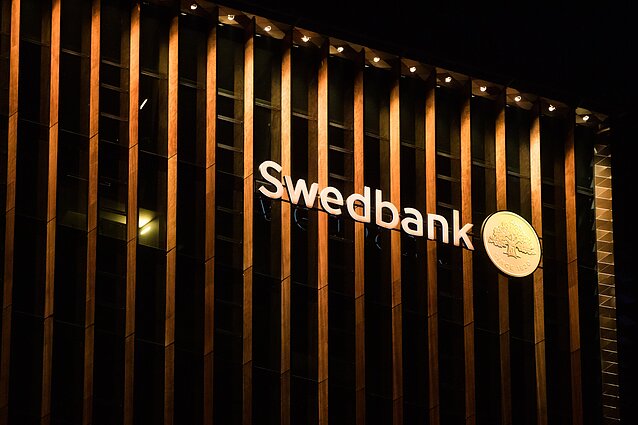
Swedbank Group has decided to form a new holding company in Latvia to unite its branches in the Baltic states, according to Swedbank’s press release quoted by the Baltic News Network.
WIth this move, the bank plans to adapt its strategy more flexibly in accordance with Latvia’s market and monitoring requirements.
Recently, Swedbank’s branches in Estonia and Latvia have been involved in high-scale corruption scandals. The US authorities are currently investigating its activities.
Swedbank AB will be the holding company’s complete shareholder and the new company will be a 100 percent owner of subsidiaries in Latvia, Lithuania, and Estonia. The holding company’s board chairman will be council chairman in each of the subsidiary banks in Baltic States, according to LRT..
Recovery will slow down
DBRS Morningstar considers that the economic recovery of the three Baltic countries, Estonia,
Latvia and Lithuania, will most likely slow down as a result of Russia’s invasion of Ukraina. In this
context, DBRS Morningstar is closely monitoring the Baltic exposure of some large Nordic Banks
which dominate the Baltic countries’ banking sectors. In this commentary we have aggregated and
analysed the data related to the Baltics operations of the major Nordic Banks in order to understand
the possible implications of a deterioration of the macroeconomic outlook in the Baltic countries on
the Banks’ financial performance, risk, and funding profile.
Exposure to the Baltics
A Concentrated Banking Sector Dominated by Swedbank and SEB
The Baltic countries’ banking sectors are relatively concentrated and dominated by the subsidiaries
of foreign banking groups together with some smaller local players. Among the large Nordic Banks
rated by DBRS Morningstar, Swedbank AB (Swedbank) and Skandinaviska Enskilda Banken AB
(SEB) have the largest exposure towards the Baltics. In 2017, Nordea Bank Abp (Nordea) and DNB
Bank ASA (DNB) combined their Baltic operations into the newco Luminor Group AB (Luminor), the
third largest bank in the Baltics by market share. Subsequently, in 2018, both Nordea and DNB sold
a 60% participation in Luminor to Blackstone Group. DNB maintains a 20% stake in Luminor while
Nordea entered into a forward sale agreement with Blackstone to sell its remaining 20% stake
gradually at a future time. At end-2021, Nordea’s participation in Luminor was 11.6%. Both banks
report their stake in Luminor as an investment in associates and account for it under the equity
method. In 2019, Danske Bank A/S (Danske) decided to close down its business operations in the
Baltics and only maintained a marginal exposure to this area at end-2021 which is still in run-off.
Meanwhile, Svenska Handelsbanken AB (Handelsbanken) has no exposure to the Baltics.
Swedbank and SEB accounted for almost two-third of the total market share in customer loans and
deposits in Estonia and Lithuania and around half of the market share in Latvia at end-Q3 2021
As a result, Swedbank and SEB have a dominant market position in the Baltics being respectively the first and the second largest credit institutions in the area. The banks remain very
committed to their business operations in Estonia, Latvia and Lithuania which they consider as
home markets.
Swedbanks largest
Swedbank serves around 3.3 million private and 300k corporate customers in Estonia, Latvia and
Lithuania. Total assets allocated to the Baltic region represented about EUR 41 billion or 16% of
Swedbank’s total assets at end-FY21. In Estonia the bank has a leading market position among
households, corporates, payment services and pensions. Total assets in Estonia were SEK 167
billion at end-2021 (EUR 16 billion) or 6% of the total group consolidated assets. In Latvia and
Lithuania, where the bank is mainly focused on private customers, total assets amounted to SEK 83
billion (EUR 8 billion) and SEK 180 billion (EUR 17 billion) at end-2021 or 3% and 7% of total
consolidated assets respectively. Swedbank had 17 branches in Estonia, 21 in Latvia and 42 in
Lithuania at end-2021.
SEB’s Baltic division provides universal banking products to private and corporate customers across
the three Baltic countries operating through a branch network of 61 branches at end-2021. The
bank serves around 1 million private customers and 105k corporate and SMEs in the area. Total
assets allocated to the Baltic region represented about EUR 24 billion or 6% of SEB’s total assets at
end-FY21 with: total assets in Estonia of SEK 78 billion (EUR 8 billion) or 2% of total consolidated
assets, total assets in Latvia of SEK 47 billion (EUR 5 billion or 1% of total), and total assets in
Lithuania of SEK 115 billion (EUR 11 billion or 3% of total).
Source: Estonian Financial Supervision Authority, Association of Latvian Commercial Banks, Association of Lithuanian Banks, DBRS Morningstar.
Higher Uncertainty Counterbalanced By Sound Loss Absorption Capacity to Date
Swedbank and SEB’s Baltic divisions have reported high returns on equity since 2017. While the
outlook remains very uncertain for the economic recovery of the three Baltic countries given the
COVID-19 pandemic has been followed by the Russia‘s invasion of Ukraine, DBRS Morningstar
considers the impact on both Swedbank and SEB’s Baltic operations could be mitigated by their
significant loss absorption capacity.
In 2021, Swedbank’s Baltic Banking division accounted for 19% of the bank’s total revenues and
total income before provisions and taxes (IBPT). The segment reported a net attributable profit of
SEK 4,093 million in 2021, down 5% YoY. The reduction was mostly attributable to a 10% increase of
operating expenses which incorporated higher costs for anti-money laundering (AML), risk and
compliance processes which could increase given the complexity of recent new sanctions.
Nevertheless, the division’s underlying efficiency remained strong with a reported cost-income ratio
of 44% in 2021 vs. 40% in 2020. The Baltic business reported a return-on-equity (ROE) of 16.6% in
2021, vs. 17.4% in 2020 (Exhibit 2), higher than the Group ROE of 13.2% in 2021. The allocated
equity was 23% of total risk-weighted-assets (RWAs) at end-2021.
In 2021, SEB’s Baltic division accounted for 9% of the bank’s total revenues and 10% of the bank’s
IBPT. The division’s profit before taxes increased to SEK 3,233 million in 2021, 25% higher than
- The increase was mostly attributable to loan loss reversals of SEK 216 million in 2021,
compared to SEK 425 million loan loss provisions in 2020. The cost-income ratio was 40% in 2021, in
line with 2020. The Baltic division reported an ROE of 22.3% in 2021, vs. 16.8% in 2020 (Exhibit 2),
higher than the Group ROE of 13.9% in 2021. The business equity represented 14% of total RWAs at
end-2021. Source: Company reports, DBRS Morningstar.




